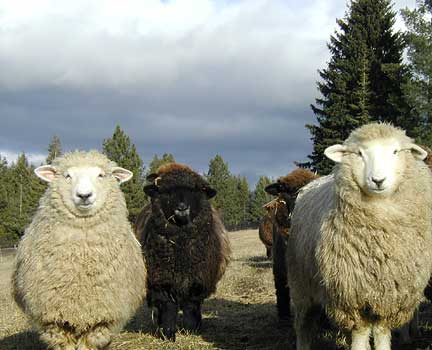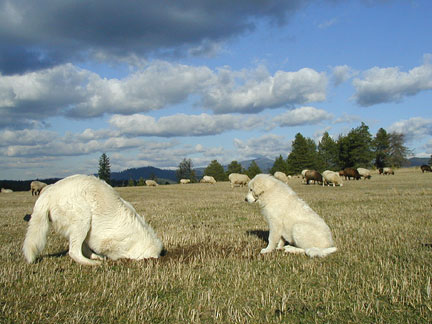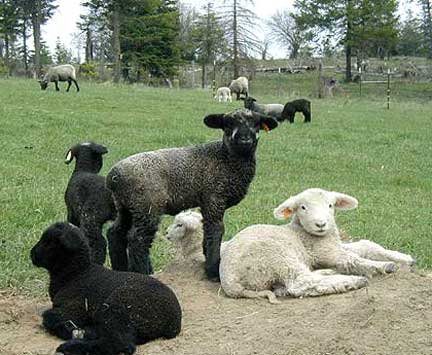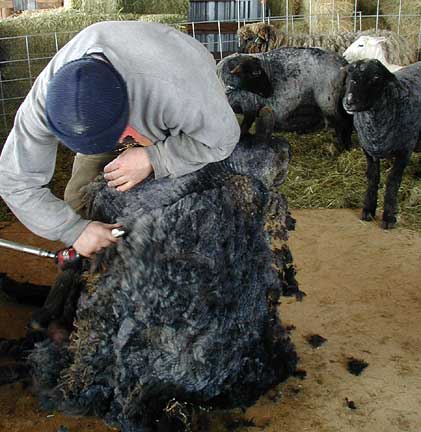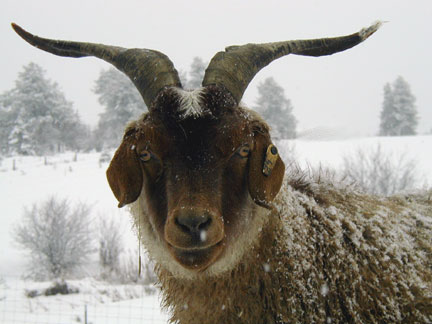|
|
|||
|
2004 PHOTOS (Click to view 2002, 2003, 2005, 2006, 2007, 2008, 2009 photos) |
|||
|
Photo
of the |
December 15, 2004 Every
fall, while the adult ewes are busy with their
rams in separate pastures, I move the previous
spring's keeper ewe lambs into the front hillside
pasture. Here they'll spend the next 6-8 weeks
under the supervision of a couple of retired ewes
and one or more of the Pyrenees dogs. Though many
shepherds breed their ewe lambs, I like to wait
till my lambs are more mature, at a year and a half
of age, before adding them to the breeding flock.
Today, all 15 of the ewe lambs rushed up when they
saw me and organized themselves into two amazingly
neat lines . . . are we going somewhere?
November 3, 2004
Angus
the Great Pyrenees guard dog demonstrates for the new
Pyr pup Daisy his annoying, ineffective, but obviously fun
technique for harassing gophers. Though I do appreciate the
thought, it's a good thing that Angus doesn't dig like this
too often, or the hayfield might start looking more like a
minefield. Thankfully also, smart pup Daisy has already
figured out that her time is better spent guarding her sheep
from above-ground threats!
July 21,
2004
Ewes and lambs at their summer jobs.
As yet another example of the "full circle" concept of sustainable agriculture, once these trees mature, many of the apples will be fed to the sheep during the flushing period before breeding in the fall. For now, every fall I pick apples from a local orchard and feed a few to each ewe every day during flushing and breeding. They love the apples, and my experience (and that of most shepherds and researchers too) has shown that increasing the nutritional level during this period helps increase the number of multiple births at lambing time.
The goats take their summer jobs seriously too. Here, they dive into a stand of weeds about to go to seed in the winter barnyard. They'll have this area completely cleared within a couple of days and these weeds won't have a chance to reproduce next year.
Grace, one of my
all-time favorite Romney ewes, delivered another
set of gorgeous black twins this year. Her lambs
are 5 weeks old today, and the ram lamb (above) has
been purchased by a young sheep breeder who's going
to pair him with Finnsheep ewes. This beautiful
boy will stay with his mom, sister, and the
SkyLines flock till he's fully weaned at about 4
months of age. Then he'll travel to his new farm
and, in time, become head ram of his own flock. I
just can't wait to see the fabulous fleeces those
babies produce!
April 14,
2004
The 2004 lambing season was a flurry of activity this year. In a short 2-1/2 week period, the hardworking SkyLines ewes delivered 60 beautiful, healthy babies. These lambs are about 2 weeks old and are quickly learning how to hang out together and "flock up." After lambing is over, the sheep always spend a few days in this safe paddock near the barn, to make sure that all the lambs know to stay with the flock and to come when they're called. Obedience to mom is critical to a lamb's survival, and each ewe insists that her lambs learn the rules. Once all the lambs are safely bonded to mom and to the flock, the entire group will move out to the hayfield and then to the woods pastures for a summer of grazing fresh green grass (accompanied of course by their vigilant guardians, the Great Pyrenees dogs.)
January 21, 2004 Five-year-old
Brownie, one of my favorites of the new
SkyLines cashmere goats, sports a rather exotic set
of horns. All 11 of the goats have horns, and when
the herd arrived here last fall I confess that I
was just a teeny bit apprehensive about those
wicked-looking appendages. I knew
that I wanted to raise cashmere in addition to
wool, but I'd never known a goat before, much less
a horned one. All of the SkyLines sheep are polled
(hornless). Considering the amount of time I spend
hands on and close up with my animals, did I really
want to keep critters with these serious weapons
growing out of their heads? Well,
not to worry. I quickly learned that these goats
are just as gentle and easygoing as the sheep! They
only use their horns with each other, banging heads
regularly in the goat's way of reaffirming herd
status. And
those horns have turned out to be not lethal
weapons at all, but convenient handles (in a
pinch), as well as highly precise back scratching
tools (note the cashmere on the tip of Brownie's
horn).
|
||||||||||||||||||||

